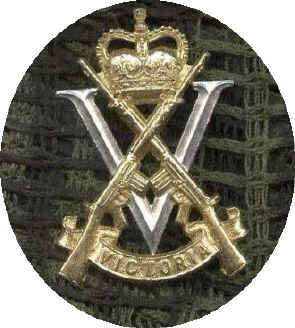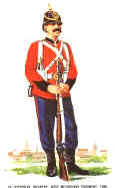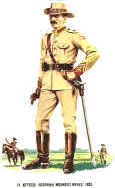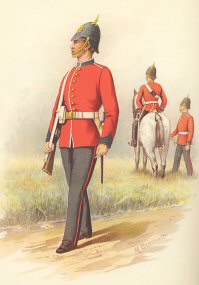 |
| Category: Army
Today/State Regts |

|
|
|
 |
Royal Victoria Regiment
RVR
The Royal Victoria
Regiment was formed on the 1st July 1960, as an amalgamation of all Army
Reserve Infantry Battalions in the State of Victoria.
It inherits and
embodies the traditions of the infantry in the State from the earliest
units formed in 1854 to the present.
To fully understand the heritage of
the Regiment it is necessary to go back to the very founding of the
Colony of Victoria.
|
 |
 |
 |
 |
 |
| Officer,
Victorian Volunteer Rifles, 1860 |
Ballarat
Volunteer Regiment, 1874 |
1st
Victorian Metropolitan Rifles, 1881 |
Victorian Infantry, West Melbourne Regiment, 1890 |
Officer,
Victorian Mounted Rifles, 1893 |
|
Melbourne metropolitan units and Victorian regional units make up the
Royal Victoria Regiment. The Metropolitan units traditions and
histories are entrusted to the 5th/6th Battalion, the Royal Victoria
Regiment. The regional unit's traditions and histories have now been
passed on to the 8th/7th Battalion, the Royal Victoria Regiment, 5th/6th
Battalion's sister unit. Table A shows a listing of the Battalions
raised in the metropolitan and rural regions of Victoria.


|
1880s; 1st
Militia Battalion (West Melbourne ) Infantry;
foreground:
marching soldier with rifle,
background:
mounted officer and Bugler on foot,
These Infantry
uniforms were based on British models
|
Lineage
|
Battalions Raised in Victoria
|
|
Melbourne
& Metropolitan Battalions
|
Regional
Battalions
|
|
Melbourne
Volunteer Rifle Regiment, 1854
|
Ballarat
Volunteer Rifle Regiment, 1858
|
|
1st
Militia Battalion, 1885
|
3rd Battalion, Victorian Mounted Rifles, 1885
|
|
2nd
Militia Battalion, 1885
|
4th Battalion, Victorian Mounted Rifles, 1885
|
|
Victorian
Scottish Regiment, 1898
|
Victorian
Rangers, 1888
|
|
52nd
Battalion AIR (Victorian Scottish)
|
.
|
|
5th
Australian Infantry Regiment, 1903
|
7th
Australian Infantry Regiment, 1903
|
|
6th
Australian Infantry Regiment, 1903
|
8th
Australian Infantry Regiment, 1903
|
|
5th
Battalion, 1st AIF, 1914
|
7th
Battalion, 1st AIF, 1914
|
|
6th
Battalion, 1st AIF, 1914
|
8th
Battalion, 1st AIF, 1914
|
|
14th
Battalion, 1st AIF, 1914
|
21st
Battalion, 1st AIF, 1914
|
|
22nd
Battalion, 1st AIF, 1915
|
23rd
Battalion, 1st AIF, 1915
|
|
24th
Battalion, 1st AIF, 1915
|
32nd
Battalion, 1st AIF, 1915
|
|
29th
Battalion, 1st AIF, 1915
|
37th
Battalion, 1st AIF, 1916
|
|
39th
Battalion, 1st AIF, 1916
|
38th
Battalion, 1st AIF, 1916
|
|
46th
Battalion, 1st AIF, 1916
|
59th
Battalion, 1st AIF, 1916
|
|
57th
Battalion, 1st AIF, 1916
|
60th
Battalion, 1st AIF, 1916
|
|
58th
Battalion, 1st AIF, 1916
|
7th Battalion, NW Murray
Regiment, 1919
|
|
5th Battalion, Victorian Scottish
Regiment, 1919
|
8th Battalion, City of Ballarat
Regiment, 1919
|
|
6th Battalion, Royal Melbourne
Regiment, 1919
|
21st Battalion, Victorian Rangers, 1919
|
|
14th Battalion, Prahran
Regiment, 1919
|
23rd Battalion, City of Geelong
Regiment, 1919
|
|
22nd Battalion, Richmond
Regiment, 1919
|
37th Battalion, Henty
Regiment, 1919
|
|
24th Battalion, Kooyong
Regiment, 1919
|
38th Battalion, Northern Victoria
Regiment, 1919
|
|
29th Battalion, East Melbourne
Regiment, 1919
|
52nd Battalion, The Gippsland
Regiment, 1919
|
|
39th Battalion, Hawthorn/Kew
Regiment, 1919
|
59th Battalion, Hume
Regiment, 1919
|
|
46th Battalion, Brighton
Regiment, 1919
|
2nd/7th
Battalion, 1939
|
|
57th Battalion, Merri
Regiment, 1919
|
2nd/8th
Battalion,1939
|
|
58th Battalion, Essendon/Coburg
Regt, 1919
|
2nd/21st
Battalion, 1939
|
|
60th Battalion, Heidelberg
Regiment, 1919
|
2nd/23rd
Battalion,1939
|
|
2nd/5th
Battalion, 1939
|
37th
Battalion, 1939
|
|
2nd/6th
Battalion, 1939
|
52nd Battalion,1939
|
|
2nd/14th
Battalion, 1939
|
37th/52nd
Battalion, 1939
|
|
2nd/22nd
Battalion, 1939
|
7th
Battalion (Militia), 1939
|
|
2nd/24th
Battalion, 1939
|
8th
Battalion (Militia) 1939
|
|
2/29th
Battalion, 1939
|
58th/59th
Battalion, 1939
|
|
2nd/32nd
Battalion, 1939
|
60th
Battalion, 1939
|
|
14th/32nd
Battalion, 1939
|
8th/7th Bn, Nth
West Victoria
Regiment, 1948
|
|
22nd
Battalion, 1939
|
38th Battalion, The Bendigo
Regiment, 1948
|
|
24th
Battalion, 1939
|
59th Battalion, The Hume
Regiment, 1948
|
|
29th/46th
Battalion, 1939
|
2 RVR, 1960
|
|
39th
Battalion, 1939
|
2nd Battalion,
RVR, 1965
|
|
57th/60th
Battalion, 1939
|
1st
Independent Rifle Coy, 1965
|
|
5th Battalion, Victorian Scottish
Regiment, 1948
|
8th/7th
Battalion, RVR, 1987.
|
|
6th Battalion, Royal Melbourne
Regiment, 1948
|
|
|
58th/32nd Battalion, Essendon
Regt, 1948
|
|
|
1 RVR, 1960
|
|
|
1st Battalion,
RVR, 1965
|
|
|
5th Battalion,
RVR, 1965
|
|
|
6th Battalion,
RVR, 1965
|
|
|
5/6th
Battalion, RVR, 1982
|
|

Battle
Honours
Many of the 1st Australian Imperial Force and the 2nd Australian
Imperial Force units were raised directly from the skeleton of militia
units after the declaration of war. For this reason, The Royal Victoria
Regiment can earned more Battle Honours than any other Regiment of the
Australian Defence Forces. Approved Battle Honours that emblazon the
Colours are listed in table B. Go to the respective unit history to see
the actual Battle Honours awarded to the various Battalions.
|
Battle Honours
emblazoned on the Colours
|
|
Regimental
Colour
|
Queens
Colour
|
|
South
Africa (1899-1902)
|
Bardia
1941
|
|
Pozieres
|
Capture
of Tobruk
|
|
Ypres
1917
|
El
Alamein
|
|
Amiens
|
Greece
1941
|
|
Mont
St Quentin
|
South
West Pacific 1942-45
|
|
Somme
1916,1918
|
Bobdubi
II
|
|
Bullecourt
|
Lae-Nadzab
|
|
Polygon
Wood
|
Finisterres
|
|
Albert
1918
|
Hari
River
|
|
Hindenberg
Line
|
Borneo
|
|
Landing
at ANZAC
|
|
 |
The
Victoria Cross
Click here
to view the names of Victorians who have been awarded the
highest bravery medal in Australia / British Commonwealth - the
Victoria Cross.
|

Activity Report
The Dibb Report of the mid 1980's saw the 5th/6th and 8th/7th Battalions
given the task of Vital Asset Protection of the Tindal Air Force Base in
the Northern Territory as their primary role. Both battalion's
participated in two large multinational Kangaroo exercises in 1989 and
1992; the battalions also sent smaller elements to the region subsequent
exercises.
In 1988, it was decided to reintroduce Colour Patches for the first time
since the end of the Second World War. The original 5th Battalion patch,
as worn the day that the 5th Battalion, 1st AIF raised from Melbourne
and landed at ANZAC cove on the 25th of April 1915 was adopted for the
5th/6th Battalion RVR. This patch, of a black rectangle on top of a red
rectangle, is worn on the puggaree on the slouch hat. The original 8th
Battalion patch, as worn on that day when the 8th Battalion landed at
Anzac Cove on 25th of April 1915 was adopted for use by the 8th/7th
Battalion RVR. This patch, of a white rectangle on top of a red
rectangle, is worn on the puggaree.
A change of Government in 1996 led to a review of the Army Reserve which
impacted directly on the 4th Brigade in general, and the 5/6th Battalion
in particular. The Brigade was to be "revitalized" and
recruitment was stepped up to increase the size of the Battalion.
Concurrently, additional Regular Army Staff were posted to increase the
readiness and training tempo of the unit. Training was well resourced
and tested by independent observers at the Cultana training area in
1999.
East Timor
The 5th/6th Battalion supplied to Company Group to rotate through the
Butterworth Air Force base, Malaysia, in Nov 1999-Jan 2000 becoming one
of the first Army Reserve units to do so. The company group was drawn
primarily from the 5th/6th Battalion. Additional strength was drawn from
8/7 RVR as well as other units within the 4th Brigade.
The events in East Timor during 1999/2000 resulted in the requirement
reinforce Regular Army units, and members of the both the battalions
volunteered for service. Most served with the 6th Battalion, The Royal
Australian Regiment. Some elected to stay with the regular Army on their
return to Australia while others returned home to their Battalion.
In July 2002, the first Army Reserve Infantry Rifle Company to serve on
peace keeping operations was raised from volunteers from both 5/6 RVR,
8/7 RVR and soldiers from 2/17th Battalion, The Royal New South Wales
Regiment.
Today the 5th/6th and the 8th/7th Battalions, The Royal Victoria
Regiment are proud to carry on the traditions, customs and experiences
of Infantrymen based in Melbourne and Country Victoria that are
enshrined within the Battalions and the various Associations. It remains
very much a part of Victoria.
|
|
Books
The following books are selected reading for further information about
the various Infantry Battalions.
|
5th Battalion,1st AIF
|
Forward with the Fifth
|
|
2nd/5th Battalion
|
All the Kings Enemies
|
|
5th Battalion
|
Espirit de Corps - A history of the 5th
Battalion and the Victoria Scottish Regiment
|
|
6th Battalion, 1st AIF
|
As Rough as Bags:
Ron Austin
|
|
2nd/6th Battalion
|
Nothing Over Us:
Sir David Hay
|
|
6th Battalion
|
Bold, Steady, Faithful - A history of
the 6th Battalion and the Royal Melbourne Regiment; Ron Austin
|
|
2nd/14th Battalion
|
The 2nd/14th Battalion:
W.B. Russell
|
|
22nd Battalion
|
Mud and Blood:
P Share
|
|
39th Battalion
|
To Kokoda and Beyond:
Victor Austin
|
|
39th Battalion
|
Those Ragged Bloody Heroes:
Peter Bruhne
|
|
58th/59th Battalion
|
Militia Battalion at War:
Russell Mathews
|
|
5th.6th,7th,8th Bn's
|
The White Ghurka's:
Ron Austin
|
|
2nd/6th Battalion
|
Not as Duty Only:
Maj. H Gullet MC
|
|
this page is a part copy of the website provided by the
Association. Some alterations have been made.
|